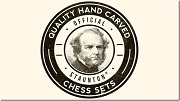1850-1991
(From 1889 to 1940 the notes are based on those written by the then Club Secretary, Mr. W. W. Loxton.)
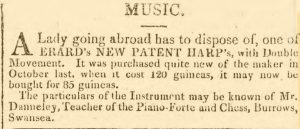
Cambrian newspaper 22nd January 1820
In 1835 a Jonathon Bradford of Oystermouth took up the challenge of ‘A Chess Player’ of Llanelli to a match by post to be reported in the newspaper. (More of that in an article on Llanelli chess club.)
There is evidence of organized chess in Swansea from at least October 1850 when the first club was formed in Wind Street. The club met at “Mrs. Young’s” in Wind Street, Swansea, and there was mention of the prospect of matches against clubs in neighbouring towns, but it seems to have been a short-lived society. Mrs. Elizabeth Young was the widow of a saddler who had moved with his family to Swansea from Hampshire. Her husband died in 1843 and she and her young son ran the business. She supplemented their income by renting rooms to the chess club. Unfortunately, she died early in 1851 and that may have led to the early demise of the fledgling club.
A new Swansea club was formed at the Cameron Arms Hotel, High Street, in November 1858. This club lasted only for a short period although the following year the club printed in the newspaper a denial that the Swansea Chess Club had merged with a Calisthenics Club! (exercise to develop elegance and grace of movement).
The club was re-formed in October 1871, meeting at the Tenby Hotel with Mr. Sidney Old as secretary and Montagu Wilmot of Norton House as President. Within a month there were reported to be 34 members. Later the club moved back to the Cameron Hotel and later again to Russell Street with J. Crane as secretary. There was talk about arranging matches with neighbouring chess clubs and one wonders where they were located. A tournament on a handicap basis was run between the members through the winter and was won by a Mr. Charles Westwood ahead of Mr. E. G. Williams and Mr. Terrill.
Charles Westwood was an accountant and insurance broker. His wife died quite young and unfortunately he was recorded as being in the workhouse in 1891.
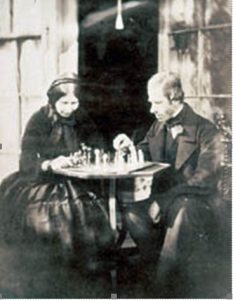
Montagu Wilmot
This early photograph dated about 1853 was taken by John Dillwyn Llewellyn, Squire of Penllergaer, Swansea
Chess appealed to the gentry, at least the cultured and scientifically minded members, who regarded chess as an appropriate game of skill and entertainment for a gentleman. Montagu Wilmot, pictured above, was a gentleman of substance from Norton House, Oystermouth, and the lady with him, Mrs. Caroline Webber was of Rhydrhelig House, Sketty. Is this the earliest photograph of identifiable chess players?
Towards the end of 1872 chess and draughts were banned from the Y.M.C.A. One correspondent wrote, “I do hope the exclusion of the Chess and Draughts will not be the cause of sending one to either the theatre or the public-house.” Perish the thought! Chess was not thought by certain committee members to be a good Christian practice.
In May 1876 another club was formed at Swansea in the Workingmens’ Club under the secretaryship of Mr. Louden. Lord Aberdare, later president of the South Wales Chess Association, had presented chess sets and boards to the club when the doors first opened a year earlier.
Whether the 1871 Swansea club lasted the pace is open to debate as one newspaper report stated that a new club had been formed in the town in the autumn of 1879. Lewis Llewellyn Dillwyn M.P. for the Swansea district, was elected president. He related that, as a boy, he had played chess against Humphrey Davy.
Match play now became evident. Two matches were arranged against a club in Llanelli. The first of these was played on Wednesday 3rd December 1879. Each player had two games and at the end of play Llanelli were leading 6-5. However, one game had been postponed until the following day and this was duly won by the Swansea player to tie the match. The Swansea team was Davidson, Dowle, Jones, C. Price, F. Richards, A. Richards and Woods. The eagle-eyed will note that Swansea had seven players which suggests that a reserve was substituted at some stage for the second round. A return match resulted in a win for the Swansea club.
In June 1880 a match was arranged against the Workingmens’ Club. The full result (town team named first) : 1. J. C. Woods 2 C. Westwood 0; 2. W. F. Richards 2 D. Davis 0; 3. J. Banfield 1 W. Hayes 1; 4. J. D. Jones 2 T. Mills 0; 5. C. Price 2 W. Miles 0; 6. W. Gibbins 0 E. Louden 2.
Born in Birmingham in 1846, W. Frederick Richards played in the first Challenge Cup final and on a high board for South Wales. He was the son of an M. P. and a colliery proprietor. He died in London in 1916. His brother Arthur also played for the club.
An old guide book to Swansea dated 1880 and issued by the British Society for the Advancement of Science as, “The Official Guide and Hand-Book to Swansea and its District”, mentions that “the Swansea Chess Club meets at Walter Road”. W. R. Bland’s Chess Club Directory of 1880 names a Swansea club with 30 members, founded in l879.
Another club opened in the town in December 1884 at the Welcome Coffee Tavern, being billed as a ‘chess and draughts club’. At the inauguration a display was given by Mr. Strickland, the blindfold draughts player of the world. In June 1885 they were still a chess and draughts club and entertained Neath club over eight boards, the Swansea team winning 22-7, but this was a draughts match.
Earlier that year the Secretary of the main Swansea chess club was Charles Price of Swansea Bank. The chess club had arisen from the very exclusive Swansea County Club and the same select conditions pervaded the chess room. Learners were not tolerated and undesirable members made so uncomfortable that they retired in disgust. The club was quite active but again it did not survive for more than a few years. A later report at a club A.G.M. commented that “membership includes professional men, business men, and those of means and leisure” – no room for the working class!
With chess in Cardiff becoming ever more popular, competition between the two towns was fierce. Matches were played over-the-board, by telephone and by correspondence. Honours were fairly even though Cardiff won both the telephone games.
The first match between the clubs was at the Angel Hotel in Cardiff in January. Cardiff won 6-5, the Swansea team being 1. J. C. Woods, 2. W. Frederick Richards 3. Charles Price 4. James Banfield 5. J. Dowle Jones 6. Arthur Richards. The match was followed by a dinner and a blindfold display by the Cardiff top board, D. Y. Mills who had won the Scottish Championship. A return match at the Mackworth Hotel in Swansea resulted in an emphatic 8-2 victory for the home side.
The telephone match played on Tuesday 18th March 1884, excited a lot of interest as it was believed to be the first of its kind to be played in Britain. Swansea lost after 31 moves. The return match took place in May and again Cardiff were the winners, the game lasting only 12 moves. The following year a three-way telephone match competition was played between Swansea, Cardiff and Newport.
The unofficial American Champion, Captain George Mackenzie, and British Master, Henry Bird, are reported to have visited the club on 11th September 1885, travelling from Cardiff the day before, but there is no record of any chess lecture or display.
Finally, a new and enduring club was born in 1888. The re-formed club met at Longlands Hotel in St. Helen’s Road. The club was known as ‘Swansea County Chess Club’, but this was altered in 1932 as the word, ‘County’, was thought to frighten off likely members. Optimistically, after just one year, the club appointed one of it members as a teacher to beginners as an inducement for young players. ‘Young’ was not defined!
One of the early secretaries was Edwin R. Louden, a shipping agent in the town, but James Glass took over around 1892. He was a very active person and the club thrived under his guidance. Unfortunately, he resigned due to work in 1894 (he moved to Ireland) and his successor, the Rev. P. Wolfers, did not have quite the same success.
RULES AND REGULATIONS
The rules seem rather quaint by modern standards. They were printed in booklet form and amongst them were:
Rule 16: “No games, except chess, shall be played in the Club Room”; and, “All the members shall form the committee”.
Rule 13: “Any resident of Swansea or within 7 miles of Swansea, may be introduced to the Club Room by any member, but not more than twice in any year. If outside the 7 miles he may be introduced at any time, provided his name be entered in a book kept for that purpose.” In October 1897 it was passed that the Secretary’s subscription be one shilling per annum. The same rule was still in being in 1940!
Their energetic Secretary, James Glass, was also chess editor of the Cambrian from 1891. His weekly articles included games, international news, problems, letters and even poetry. For a short while the town could boast of two chess columns. Frederick Tucker wrote for the Mumbles Observer from 1889 even though he moved first to Pontypridd and then to Bristol.
Inside the club there were simultaneous displays by members, internal matches such as “Married v. Single”, friendly inter-club matches, problem solving competitions, a correspondence match with Bath and telephone matches to supplement league activity.
In 1889 there were two clubs. Swansea County Club met at Longlands on Wednesdays and Saturdays whilst the Swansea Chess & Whist Club met at Walters Road on Tuesdays. By 1893 there was a short-lived Liberal Chess Club in the town.
Admission to the club in the early days was not easy. Your profession and possibly your antecedents were scrutinized. The proposer and seconder had to vouch for your character, your name had to be exhibited on the notice board for three weeks, and the new member was then elected by ballot, but “two black balls shall exclude.”
FEES AND FINANCE
The annual subscription was usually 10 shillings and 6 pence, but during the First World War it doubled to one guinea. The financial position was generally precarious but, owing to the generosity of Colonel W. Ll. Morgan and later, Dr. Hanson, the club was kept solvent. Several times a whip-round was asked for and as much as five shillings per head received.
Colonel Morgan had settled in Swansea in 1888 and owned much of the land on which St. Helen’s and Brynmill were built. He was a great benefactor not only of the chess club but also of the Royal Institution of South Wales, being its President sixteen times between 1890 and 1926, and of the church, donating the land on which St. Gabriel’s Church was built. He died in 1927.
Sir George Newnes, M.P., was elected President in 1910 for purely mercenary motives, although he had been a great benefactor of chess throughout Britain for many years. Colonel Morgan was demoted to Vice-President. Very little benefit came out of this manoeuvre for on June 9th the same year Sir George died and the following year the Colonel was re-instated with Sir Alfred Mond, M.P., being elected Vice-President.
Dr. Alfred Hanson (1862-1940) was a medical doctor and is best remembered for the West Wales Chess League Division One trophy which carries his name.
Chess and backgammon were the only games permitted in the House of Commons. The British Chess Magazine of December 1890 quoted an article from the ‘Hereford Times’ which said that George Newnes, the President of the British Chess Club (and the City of London Chess Club), was the strongest player in the House of Commons. By 1900, when he became M.P. for Swansea, he had virtually given up playing although he was still recognised as head of the chess circle in Parliament and was acknowledged to be a very generous patron of the game. Sir George donated the trophy that was competed for between Britain and America in an annual cable match. He is best remembered for his publishing empire.
MEETING PLACES
In the 1890s the meetings were held at the Longlands Hotel, which was a good class commercial hotel on the corner of Page Street. For some reason the venue changed to 28 Walter Road in 1898. The tenant of that premises, which was a furniture shop, let rooms upstairs to the Whist Club. He objected to the new arrivals as he had not been consulted over their move. The problem was swept aside with the announcement that the new arrivals represented the Chess Section of the ‘Chess and Whist Club.’
There were Handicap Tournaments, Gambit Tournaments (Evans of course), and many other diversions in what appears to have been a thriving late Victorian club although membership was never more than 20.
The club stayed at Walter Road for a year and then transferred to the Tenby Hotel where they negotiated a room at three shillings a night. Several members objected to meeting in a public house and one Nonconformist minister was so bitterly opposed to the idea that he resigned. This same gentleman claimed to have discovered a new opening – but he could not win with it!
The club moved back to the Longlands Hotel in 1907, where they stayed until 1912 when the premises were pulled down to be rebuilt as the Y.M.C.A. A room was offered in the new building at £7 per annum, an offer which was readily accepted. In January 1917 the Red Cross took over the Y.M.C.A. building and the club moved briefly to the Mond Buildings which were commandeered in October the same year for military purposes. The club finally returned to its home at the Y.M.C.A. in October, 1919, after further short stays at the Tenby Hotel and the White Rose Hotel. The Y.M.C.A. remained the meeting place of Swansea Chess Club until the 1980s.
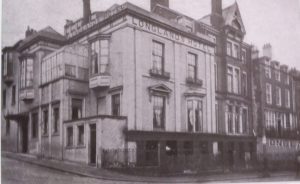
Longlands Hotel, later the site of the Y.M.C.A.
CHESS AT THE CLUB
The prize complex evidently loomed large in the early days of the club as, in the Treasurer’s Report, the Prize Account amounted to £5, paid entirely by Colonel Morgan.
A programme drawn up by a sub-committee of the 1890s shows the keen nature of the competition at the club:
“1. That a prize be given to the player who wins most private matches.
- A match between ‘Lawyers and Doctors’ against ‘Best of Club’.
- A match between the first six and the last six at odds of a rook.
- Hard matches – particulars to be arranged.
- A match ‘Officials of the Club’ versus ‘Remainder of Club’.
- Consultation games.
- That a prize be awarded to the member having the best percentage of won games each month – a minimum of six games to be played.
- A prize to be given to the player scoring the prettiest mate of the month.
- Simultaneous play to be encouraged and arranged.
- That a periodical (The British Chess Magazine) be procured for the use of the Club.
- A prize be given to the member playing the most games from 1st October to 31st December.
- That a prize be given to the player winning most games against First Class players from 1st October to 31st December.
- That the Secretary obtain a photograph of players in the Hastings Tournament (price 5/-) to he hung in the Club Room – this to be bought out of prize money and presented as a prize at the end of the year.
- A match – Club versus Outside Players for Saturday afternoon if it can be arranged.”
A more comprehensive list of suggestions would be difficult to imagine. They were certainly novel and ingenious, but there is evidence that some of these plans were unworkable for there were several amendments at subsequent meetings.
CHESS AFTER 1940
The formation of the West Wales League with the Swansea Club at its hub, stimulated clubs both in other parts of the town and in the outlying districts.
The original Chess Club always remained distinct from the Y.M.C.A. although its members were a part of it. In the early Thirties a rival club developed in the same building led by T. C. Hughes and called themselves ‘The Rooks’. There was almost a class distinction between the two clubs but the rivalry was always friendly. The popularity of ‘The Rooks’ led to a falling off in the membership of the Swansea Club and it came as no surprise when the two were amalgamated around 1934. In 1932 the Y.M.C.A. chess club was noted to have 72 members, 12 of whom were juniors!
Play continued throughout the war, including black-outs and 13 air-raids. Stan Cole, Club Secretary 1923-1935 and later President, had his house destroyed in the Blitz. Later he took rooms in the Y.M.C.A. building and died in 1967. Mr. Cole, though for a long time one of the Club’s leading players, rarely took an active part in the playing of the game after the war. However, he worked hard to develop chess in the West Wales league and in local schools. He would play anyone but is reputed never to have scored a game and if his opponent did so then he would take the score from him and rip it up! A dinner was held on the occasion of his 80th birthday, at the Dolphin Hotel, in February 1964, which was well attended and reflected the high esteem in which he was held.
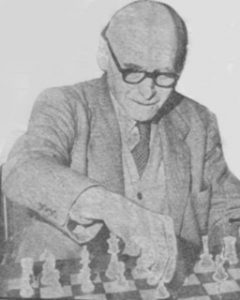
Mr. Stan Cole (1884-1967)
The fortunes of the club fluctuated with the popularity of the game in the surrounding area. Whilst there were few clubs, Swansea flourished, but with increasing activity, especially in the sixties, players left the Y.M.C.A. to join the satellite clubs.
Thus, one of the club’s greatest gains was made when the Gorseinon and Cwmamman clubs folded and Arthur Jones travelled to Swansea to become and remain for nearly twenty years, their leading player. He died in 1971 at the early age of 57.
The greatest loss to the club was due to the re-formation of Llanelli chess club in 1963 when many fine players, including D. Jones and W. V. Davies left the Swansea club. Thereafter, although still a force to be reckoned with, the club lacked the strength to compete with the superb University teams of the late 1960s which were led by G. Chesters, M. J. Lexton and F. Clough.
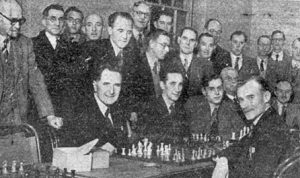
West Wales players at Swansea Chess Club February 1953 preparing for National Chess Week when T.C.Hughes went to London for a radio broadcast. In the picture are T.C.Hughes (seated left), E.D.Holland, G.Davies, S.Cole (standing far left), C.Carpenter, J.Robinson, R.H.Spear, A.E.Davies, A.O.Jones (far right), Dr. G.L.Lewis (second from right at back), E.Phillips, E.L.Williams, and F.N.Cann (seated far right).
Despite the loss of members and some fall in strength, the Y.M.C.A, remained the centre of chess in the area. Meetings were held there twice a week and the room was always full, not just with local players, but also with visitors from the surrounding clubs. Messrs. T. C. Hughes and A. D. Nicholson, two organisers of the highest reputation, made any newcomers feel immediately at ease, and the resident master, A.O. Jones, would take on all and sundry, regardless of strength or experience.
Thomas Charles Hughes (1889-1969) had a remarkable record as a chess organiser. He was the club’s main administrator from 1933 onwards, but he also served chess with distinction elsewhere. He was secretary of the South Wales Chess Association between 1935 and 1954 and secretary of the West Wales Chess League between 1933 and 1966. He was one of the few people who were made Life Vice-Presidents of the Welsh Chess Union before its separation from the British Chess Federation and it was he who formally proposed the formation of a Welsh Chess Union, stating at the time that he was one of only two obviously Welsh men present.
CLUB CHAMPIONS
The most successful tournament at the Victorian club was one which divided the contestants into three classes, each class having about eight players. Class One had to give KB Pawn and move to Class Two and a Rook to Class Three. Class Two gave a Knight to Class Three. The silence could be felt in the room during this ordeal and so many attended that it was felt larger rooms would have to be taken. Chess pieces were specially made to be given as prizes and some cost as much as £4. Dr. Hanson was the most successful player and won almost a complete set of chess pieces.
The record of winners is:
| 1903 | Col. W.Ll.Morgan | 1913 | T.D.Cullis |
| 1904 | J. Moy Evans | 1914 | Dr. W.M.Varley |
| 1905 | Dr. A.Hanson | 1915 | Dr. W.M.Varley |
| 1906 | Dr. A.Hanson | 1916 | Dr. A.Hanson |
| 1907 | Rev. E. Griffiths | 1917 | Dr. W.M.Varley |
| 1908 | Dr. A.Hanson | 1919 | Dr. W.M.Varley |
| 1909 | Dr. A. Hanson | 1921 | Dr. A.Hanson |
| 1910 | …… Lloyd | 1923 | S, Bevan |
| 1911 | …… Lambert | 1924 | P. J Rosier |
| 1912 | …….Lloyd |
A more modern tournament was started in 1894 when the President, Colonel Morgan, presented £5 in prize money for a ‘Leipzig’ tournament to be run. The Class A players would play each other, Class B the same and so on, with the winner of each group having an equal share of the prize money. The Class A event was won by Mr. M. F. Lee, with 3½ /4 and he was thereafter regarded as club champion. Lee is an enigma as he was obviously a very strong player, frequently giving displays in the club and giving odds to fellow members; but he only stayed in Swansea for a few years and there is no other trace of him.
The only other person quoted as an early champion was the Rev. Evan Griffiths in 1907, scoring 10 out of 11; but this victory refers to the Handicap tournament.
The prolific Dr. William Mansergh Varley was Principal of Swansea Technical College from 1910 and left in 1919 for a similar post in Brighton. He lost in the final of the Sussex county championship in 1929 and supported a very strong college team of students.
In 1942 a Cup was presented by Mr. D. M. Evans, Swansea’s leading player in the 1920s and a Vice-President of the club.
The first winner was Mr. S. Cole in what must have been one of his last seasons of serious chess. Notable later winners were William D. Minty 1943 and 1845, one of the main contenders for both South Wales and Welsh Championships; Janis Udris 1950, then reigning South Wales Champion; Arthur O. Jones 1953-4 and 1959-61, a South Wales and Welsh champion; and Dr. Glyn Ll. Lewis 1956-7, winner of the South Wales Championship in 1952 and for about twenty years one of West Wales’ leading players. The latter promoted chess by running a column in the Evening Post between 1961 and 1967 under the pseudonym ‘Checkmate’ and was match captain for the West Wales zone over the same period. He became a consultant at Singleton Hospital.
Winners of the D.M.Evans Cup were:
| 1942 | S. Cole | 1950 | J.Udris | 1959 | A.O.Jones |
| 1943 | W. D. Minty | 1951 | G.R.Davies | 1960 | A.O.Jones |
| 1945 | W. D. Minty | 1952 | R.H.Spear | 1961 | A.O.Jones |
| 1946 | A. A. Davies | 1954 | A.O.Jones | 1963 | D.W.Rees |
| 1947 | F. Humphries | 1955 | A.O.Jones | ||
| 1948 | T.D.Williams | 1956 | Dr.G.Ll.Lewis | ||
| 1949 | M. P. Hussey | 1957 | Dr.G.Ll.Lewis |
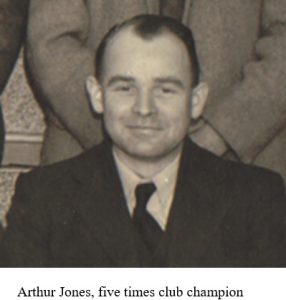
The 1950 tournament was won by a Latvian resident in Swansea. He beat all his other opponents. Janis Udris was a 26 year old refugee who had escaped to Denmark and then travelled to Swansea where he married his Latvian wife in 1948. Shortly after winning this Championship he and his family moved to London where he worked for I.C.I. and died in 2014
Later winners of the Cup did not have their names engraved on the trophy and their triumphs are not recorded elsewhere.
THE PLAYERS
In the early days chess was looked upon as a prerogative of the rich. The leading doctors, clergy, lawyers, architects, surveyors and retired officials of Swansea were the original members. Juniors were of course non-existent and the first lady player did not appear until the 1925-6 season.
Several of the club’s local players have already been noted, but over the years there have been many other celebrities who have frequented the Y.M.C.A. during their stay in Swansea.
Early club stalwarts in late Victorian Swansea were the Reverends John Pollock, Vicar of St. Gabriel’s, and P. Wolfers, Chaplain to Seamen and leader of the Jewish community in the town between 1893 and 1899, who gave simultaneous displays and offered book prizes to anyone who could beat them. Rev. Phillip Wolfers was a Hebrew minister, originally from London, and stayed in Swansea 1893-9 before leaving for Cardiff.
John Pollock was born in Scotland and had been a curate in Swansea since 1886. He was the younger brother of William Henry Krause Pollock (1859-1896), one of the leading players in Britain. Both men finished their education in Ireland but whilst William gave up his chosen career as a surgeon to concentrate on chess, the younger John took holy orders. William was a very gifted player and beat the world champion, Steinitz, on the only occasion that he played him. John was not in the same league but nevertheless was regarded as one of the strongest players in South Wales.
This is a typical swashbuckling game from 1900 played in a match between Swansea and Llanelli:
White: Rev. J. Pollock Black: H. Samuel
1. e4 e5 2. Nc3 Nc6 3. f4 exf4 4. Nf3 g5 5. h4 g4 6. Ng5 h6 7. Nxf7 Kxf7 8. d4 d6 9. Bxf4 Bg7 10. Bc4+ Ke8 11. Rf1 Bxd4 12. Qd3 Nf6 13. e5 Qe7 14. 0-0-0 Bxe5 15. Bb5 Bxf4+ 16. Rxf4 Kd8 17. Rdf1 Ne5 18. Qd4 c6 19. Rxf6 cxb5 20. Rxd6+ Bd7 21. Nxb5 Re8 22. Rd1 Rc8 23. Qxa7 Rf8 24. Rxd7+ Nxd7 25. Qb6+ Ke8 26. Nd6+ Qxd6 27. Qxd6 and wins.
James Chapman Woods, the first Chairman of the S.W.C.A. was, with Pollock, one of the few West Walians in the teams to play matches against Bristol. Born in Yorkshire, he became a lawyer and formed a partnership in Swansea. He specialised in colliery work and became President of the Swansea Law Society. Woods wrote a number of books, including a guide to Swansea, Mumbles and the Gower and was regarded by none other than Dylan Thomas as Swansea’s greatest poet.
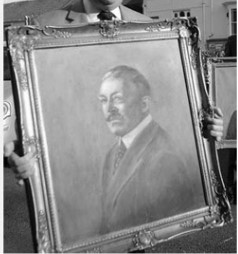
Photo: Evening Post
Portrait of James Chapman Woods found in a Swansea solicitor’s firm in 2014
J. A. Lewis (1889-1944), who had played for the British team and in 1940, was champion of Leeds, played for the club for several years in the 1930s. He was an authority as a composer of Fairy Chess Problems. A contemporary member noted that he often refused to play in matches under his own name in case he should be defeated and news of his loss filter back to his colleagues in England!
Walter J. Woods of London set up business in the town as an optician and is said to have spent most of his time, both in and out of work, composing problems. He was the club’s number two player in the early 1930s. His composing specialised in four-movers. The following problem won him first prize in a B.C.M. Three-Mover competition, August 1930.
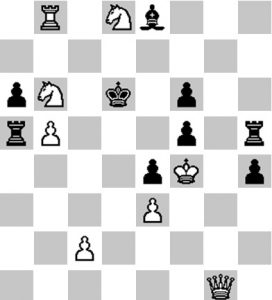
The solution reads 1. Qg8 Kc5 (or B moves) 2. Qf8+. If 1… Kc7 or Ke7 2. Rb7+.
If 1….Rxb5 2. Qe6+. If 1… others 2. Qd5+
The leading Swansea player before the start of the last war was Senor Jose Dauber, Consul for Uruguay. He captained the club for many years and retained his membership whilst serving his country in Liverpool and London. He was very much the diplomat and Swansea’s senior chess player. Mr. W. D. Minty, later of Sketty Club, could recall him wanting “young Minty” in the team. He kept on referring to him as such when nearly forty years of age as most of the other members were considerably older!
C. de Braga Mello, Consul of Brazil, was also a member of the club for a short period, 1928-9.
Junior club members were a rarity in spite of the fact that Mr. S. Cole taught chess at his school. Women players were even rarer. A 1926 report names a Miss Ashbridge as the club’s first lady member. (She was probably the daughter of the club secretary).
COMPETITION – SOUTH WALES
The South Wales Challenge Cup was first fought over in the 1888-9 season and Swansea dominated, winning four of the first eight competitions. They had to wait until 1960 however before again laying hands on the trophy.
1889 The final was played at Longlands Hotel in Swansea and the home team easily beat Newport 8-4. The Swansea team was 1. James C. Woods 2. Rev. John Pollock 3. James Glass 4. Edwin Louden 5. W. F. Richards 6. William Cann.
Glass and McCann were partners as colliery proprietors and agents.
1890 Cardiff provided the opposition and were beaten 6-4. Pollock led the team ahead of Woods, Louden, Cann, Glass and Henry J. Hayes.
1893 The Black Lion Hotel in Aberdare was the venue for this final and the home side were beaten 1.5-7.5. Woods played on top board ahead of M. F. Lee, Louden, Glass, Cann and David McCleod Craik.
David McLeod Craik played in the winning team in 1894. His father was a Scottish travelling draper and David was born in Neath in 1873 but spent most of his early years in Swansea where he was articled to Alfred Bucknall and Edward William Jennings 1889-1893 before moving to Edinburgh. From there he went to Belfast where he played in the 1897 Ulster chess championships. He went on to have a distinguished career as an architect particularly in Singapore, dying in Penang in 1938.
1894 Again there were new opponents from Rhondda in the final and the match was played at a neutral venue in the Walnut Tree, Aberavon. Woods was once again leading the side above Rev. P. Wolfers, Glass, Cann, McCleod Craik and Dr. Frederick Knight.
Dr. Frederick Knight was a surgeon in the town and also involved in local politics.
1896 Swansea’s final success in this era saw them beat Llanelli at Longlands Hotel 7-2. The Swansea team was Rev. Pollock, Cann, Rev. Wolfers, J. H. Ashbridge, Dr. Knight and Charles H. Norton.
Charles Norton was a solicitor from Oystermouth and he died a few years later.
1960 After 1954 the Challenge Cup became an all-Wales competition played for on a knock-out basis between the winning club from each Welsh zone. Swansea had been beaten finalists in 1958 and 1959, losing on each occasion to Cardiff, but were successful at last in 1960 against the same opponents. The score in the final is not known but the Swansea team in the semi-final was: A. O. Jones, D. J. Youston, Dr. G. Ll. Lewis, W. D. Minty, E. A, Mordecai and L. Webborn.
Youston had been a leading student chess player during his days at Oxford in a team led by Leonard Barden.
1962 The club’s final success in this competition was at Swansea against old rivals, Cardiff, winning the match 5.5-2.5. The Swansea team was A. O. Jones, D. J. Youston, Dr. G. Ll. Lewis, D. Jones, M. J. Baker, M. J. K. Griffiths, V. Davies and W. D. Minty.
This was a sign of a new generation of players arriving. The energetic Dilwyn Jones took on the role of secretary and treasurer of the West Wales League before leaving the chess scene completely. He and his young friend Vivian Davies soon left Swansea for a new club in their home town, Llanelli. Davies became head of the Egyptology Department at the British Museum. Michael Baker was another young player who went on to win the West Wales Championship.
COMPETITION – WEST WALES LEAGUE
Swansea, as the largest club, naturally dominated the West Wales League, winning the title ten times. This was particularly the case prior to 1960 when often only three or four teams competed. The club won the league 1935, 1936, 1953, 1956, 1958, 1959, 1962, 1966, 1974 and 1975.
The teams of 1974-5 were led by John Day and Ralph Cook, and featured a young Peter Bevan.
Sadly, the club folded in 1991.
SIMULTANEOUS DISPLAYS
The grand old man of British chess, Joseph Henry Blackburn was born in 1841 and was still playing excellent chess in 1914 when he tied for first place at the British Championships. One estimation is that he played over 100,000 games in his lifetime. His tours were ever popular. He is recorded as visiting Swansea four times; 1889, 1893, 1898 and 1911.
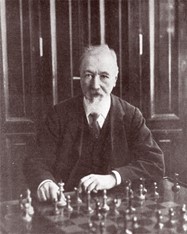
Joseph Henry Blackburne 1841-1924
The first of these occasions was at the Longlands Hotel in December, 1889. Play took just over two and a half hours during which time he beat 23 opponents and only conceded a draw to the Reverend J. Pollock. The Reverend Pollock commented, “I ought, as Blackburne acknowledged, to have won, but you know the difficulty of playing well when everyone is crowding around you telling you the best moves, which are always the worst. Blackburne thinks double. He thinks over the board and he thinks blindfold. He comes to your board and says, ‘Let me see, I can win queen for two rooks, then play Kt to Kt5 and win another pawn’ (sotto voce), and then plays something quite different. He must have thought of the combination he spoke of, and he must have thought of the combination he did not speak of. Ergo, he thought blindfold and he thought over the board.”
Blackburne paid his next visit to Swansea in March 1893 when he took on eight club members at the theatre of the Royal Institution. Blackburne was blindfolded. Tickets were issued for the event and costs were defrayed by the club’s President, Colonel Morgan. He lost to J. C. Woods and drew with the colonel.
The Cambrian reported on his visit: “A large number of chess players and friends, including many ladies, assembled in the theatre of the Royal Institution on Monday evening, to witness the first blindfold performance ever held in Swansea. Mr. Blackburne has played simultaneous games on previous occasions in Swansea but the strain of blindfold play is too great to play often.” Play began at 7 p.m. “when the blindfold player seated himself in an armchair, with his back to the eight boards, and regaled himself with a cigar.” The first game had finished by 10 p.m. and the last at 11.30 p.m. “The task that Mr. Blackburne had been set was so great, and the consequent effect so severe, that only a trip next day to Langland Bay set him right again.”
In January 1898 his record was won 18 drew one. It was noted on this occasion that he played 1. e4 on every board and he smoked continuously throughout the display. He had a policy of exchanging queens, commenting, “ Better get rid of her in case I should make a slip with her.” The man who prevented a white-wash was Dr. Knight.
The 1911 visit was part of his farewell tour. The old master, known as ‘The Black Death” was now 70 years of age, but his skills had barely diminished. He won 14, drew 3 and lost 2.
The World Champion, Dr. Emanuel Lasker of Germany, gave displays in the town twice, in 1895 and 1905. He toured six South Wales clubs in 1895 and only conceded one loss at Cardiff. He demolished all his Swansea opponents on 8th November. He repeated this is 1905 when all 21 games resulted in wins for the grandmaster.
The American Grandmaster Frank Marshall visited on 12th November, 1912, winning 3, drawing 1 and losing 1 game.
The Serbian Grandmaster, Boris Kostic, was next to visit ten years later after winning the Hastings International Chess Congress. He was unbeaten, drawing two of the 24 games played, against club stalwarts Dr. A. Hanson and S. Cole.
The British Master, Fred Dewhurst Yates, made extensive yours of the Welsh clubs in the 1920s and included two visits to Swansea in 1923 and in 1925. In the first he conceded just one draw to O. Kirth, in the 23 games played and, in the latter, he repeated the score, drawing with D. M. Evans. He won the British Championship six times.
On 1st October 1935 Sir George Thomas who had won the British title the previous year, took on 24 players. His fee was two guineas which he donated to the Nottingham International Tournament, plus £2.10.0d. expenses. He drew two games and his successful opponents were R. Johnston of Swansea and J. McGarry of ‘The Rooks’.
On 4th November 1937 the Russian master and author, Eugene Znosko-Borowsky, took on and beat 27 opponents.
The Women’s’ World Champion, Vera Menchik, took 5¼ hours over her display on 22nd February 1938. She beat 22 opponents and lost to P. J. Dauber and to Idwal John of Morriston. The fee to take part in the display was two guineas.
9th April 1940 Baruch (Barry) H. Wood played 17, results not known.
After the war many of the world’s best players took part in the Hastings Chess Tournament which was held over the New Year. In order to help pay for their visits they then undertook extensive tours of Britain giving simultaneous chess displays.
In February 1946 the German octogenarian, Jacques Mieses took on 25 players as part of his tour of South Wales clubs. He lost just one.
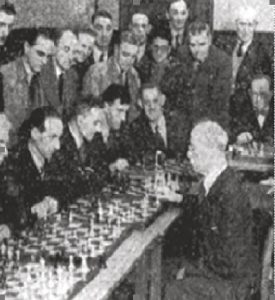
Jacques Mieses about to play against J. Robinson
29th January 1947 Imre Konig, a Hungarian master, won all 26 games.
7th February 1951 Harry Golombek was three times British champion and was made an honorary Grandmaster in 1985. He won 23 and drew 4 at his display.
11th February 1954 Robert G. Wade, a New Zealander by birth and another British champion, won 22 and lost to M. A. Maxwell, D. R. Jones, Rev. N. Perrin and L. Powell.
February 1957 Znosko-Borowsky returned to the town after twenty years and won all 32 games played.
7th March 11958 C. H. (Hugh) O’D. Alexander, like Golombek a British champion and war-time code-breaker, visited, played 28 and only conceded one draw to Dr. G. Ll. Lewis.
In I960 another British champion, Leonard W. Barden visited, winning 26, drawing 2 with L. Webborn and G. Clement and losing to D. J. Youston and G.G. Rollings.
Baruch H. Wood made his second known trip to Swansea in 1962. He ran ‘Chess’ magazine and a chess emporium from Sutton Coldfield railway station. His British tours giving displays were almost never-ending and mainly served as fund-raisers for his business. He won 2, drew 6 and lost 6. Commenting on this poor display he growled, “There was, I think, too much advice flying around.” He was runner-up in the 1948 British Championships.
25th February 1967 Owen M. Hindle, a strong player from Norfolk, won 15 drew 3 to D. W. Rees, Ian P. Eustis and E. Mordecai and lost 3 to F. Humphries, Gerald Jenkins and Paul B. Scott.




